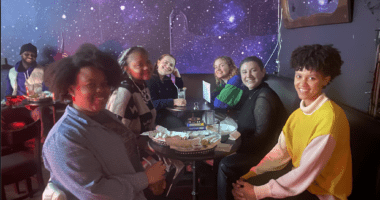One of my favorite quotes in the world, widely attributed to Albert Einstein, reads, “Everybody is a genius. But if you judge a fish by its ability to climb a tree, it will live its whole life believing that it is stupid.” Howard Gardner, the Harvard psychologist famous for pioneering the theory of multiple intelligences, sums this up more simply: “It’s not how smart you are, it’s how you are smart!”. This refreshing perspective has the power to expand our often limiting definitions of academic excellence, and to set up an environment in which students can succeed and thrive.
In the TATIP seminars, we were exposed to Gardner’s intelligence categories and asked to explore how each of these function within our own creative processes. This focus on incorporating a variety of learning styles and art forms into every residency is a large part of what attracted me to the program initially. I have not been disappointed: I have witnessed everything from song and dance to science experiments during the weeks that my residency internship has taken place.
My mentors open every session with the call-and-response song Che Che Kule, and end with the Peace Power chant (“You have to think something good! You have to say something good! You have to do something good! Power of the head, power of the mouth, power of the heart! Peace…power…”). The consistency of these rituals is both comforting and exciting for the students, setting the space with a burst of energy and personalized gestures. Every week, hands erupt into the air when Katie or Max ask who wants to be chosen to lead the class through the exercise. However, there is much more depth to these activities than just some enthusiastic fun before the “real lesson” begins. Already, in these brief introductory and closing moments, the class is diving into the use of three intelligences: bodily-kinesthetic, musical, and interpersonal.
I realized that, true to TATIP’s “Be prepared” classroom management motto, all of this is connected in a balanced and intentional way. The larger themes of Katie and Max’s residency, the three C’s of Collaboration, Community, and Creativity, are brought to life in every moment they spend with the class. Some of the main lessons have centered on the creation of community collages, individual poems, a class poem, and a group performance. The group activities and collaborative projects foster interpersonal communication, where students can relate and cooperate with one another within their table groups and by building the classroom community as a whole. Meanwhile, the reflection activities and individual projects allow for intrapersonal understanding, giving them a chance to follow their own intuition and express themselves creatively.
I always feel like I am witnessing a secret science as I watch the lessons of my mentors unfold. They manage to effortlessly combine several of the intelligences into activities that are – surprise surprise – still educational, yet feel so natural, and so far from a boring textbook. The art forms they each embody (Katie with theater, and Max with visual arts) are highlighted throughout, but always complemented by a wealth of other creative material. Each student chose a gesture to pair and perform with their poem, giving them license to both discover bodily movement and unleash their inner thespian. For the spatial learners, visual art has been constantly present through drawings paired with writing assignments, the cutouts of the collages, and most recently, with an introduction to mixing and painting with watercolors.

Verbal and linguistic play come alive with poetry and the crafting of “juicy words,” where students are asked to use all of their senses in their descriptive language. On my first day there, we left the classroom (!) and went on a neighborhood walk to learn about setting, recording our observations as proper naturalists would. More recently, activities involving studies of the growth rings in tree stumps and the properties of water (as well as ink and paint) have simultaneously taught us to wonder at our environments and to develop a logical / scientific reasoning awareness through hypothesis and experimentation.
However, there is always one moment that stands out to me the most. I love it when the class starts getting rowdy and losing focus. Yes, I just wrote those words – I love it when things start getting hectic and out of control. When this becomes a problem, Max or Katie will stand still and softly begin a magical song that goes “Silent bodies, silent chairs, silent bodies, silent chairs…” With the first two words, they will gently rise their hands in front of them, and with the next two words, turn their palms down and sink their hands just as gently. This song, always initiated at a quiet volume, slowly spreads around the room and seems to put the students in a trance. Within moments, they are all standing in place and singing the song, making peaceful waves with their hands.
I believe that this technique is a measure of true intelligence. My mentors have taken the wisdom of these often-overlooked learning styles and used them creatively to address a problem that confronts every teacher at some point: classroom management. Without ever having to raise their voices, they are able to transform the atmosphere back into a space for learning, by using a (musically intelligent) learning activity.
This expansive educational philosophy is vital because it can be applied both inside and beyond the classroom. Viewing the same assignment through many different lenses gives students this transformative life skill: the ability to creatively problem solve. Instead of becoming frustrated and possibly even giving up (“I can’t understand what this means!”), we can instead teach them to look at it from another angle (“How can I understand what this means?”) As the teachers and artists of the future generation, it is our responsibility to model this fusion of creative and critical thinking within our lesson planning and within our classroom management.
-Megan Skelly, Writer, TATIP Trainee



